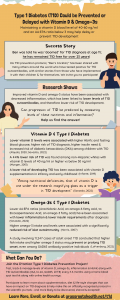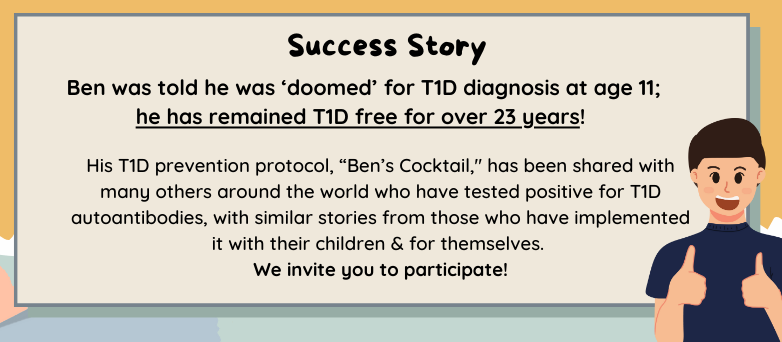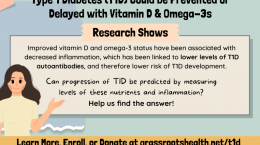Published on May 3, 2024
The progression of type 1 diabetes can be greatly affected by an individual’s vitamin D status and by their ratio of fatty acids AA to EPA
Key Points
- There is now much published evidence on the relationship between vitamin D, beta cell function, and the progression or severity of T1D; a recent systematic review found a strong association between lower vitamin D levels and the development and diagnosis of T1D, with “high-level evidence that adequate vitamin D status in early life reduces T1D risk”
- Another study showed that the T1D children who were supplemented with vitamin D had lower levels of fasting blood glucose (FBG), mean blood glucose (MBG), HbA1c, and mean total daily insulin dose (TDI); these findings overall indicate a protective effect of vitamin D on residual beta cell function
- The D*action T1D Prevention protocol including vitamin D and omega-3 fatty acids has now been shared with many others around the world who have tested positive for the T1D autoantibodies, and we are receiving similar stories from those who have implemented it with their children, and for themselves. We now invite anyone who shares this experience, or who would like to give this protocol a try, to become part of our T1D Prevention Study.
 A protocol involving vitamin D and omega-3s is now being implemented to help decrease the progression of T1D among those at risk. Take action for yourself or someone you know who may be concerned about Type 1 Diabetes. Share this information with them today!
A protocol involving vitamin D and omega-3s is now being implemented to help decrease the progression of T1D among those at risk. Take action for yourself or someone you know who may be concerned about Type 1 Diabetes. Share this information with them today!
Learn More About the T1D Prevention Project
Order Your Test Kit & Enroll Here
In most individuals with Type 1 Diabetes (T1D), insulin secretion declines as time progresses after diagnosis. However, residual insulin secretion has been observed among 10-30% of those with T1D, even 30-50 years after diagnosis. This indicates what is called Residual Beta Cell Function (RBCF). In fact, an estimated 30-50% of beta cell function remains at time of T1D diagnosis.
Residual beta cell function (and residual insulin secretion) can be determined by measuring circulating C-peptide levels in response to a meal (called the stimulated C-peptide response). C-peptide is a molecule that is released by the pancreas when it makes insulin; the lower the C-peptide level, the less insulin is being produced.
A study among participants who had been living with T1D for about 10 years found that those who retained a stimulated C-peptide response had significantly lower levels of HbA1c (showing better blood sugar control), a 65% lower risk for severe hypoglycemia, and a 50% reduced risk of retinopathy progression compared to those who did not have a C-peptide response. It has also been shown that those who had better glycemic control and retained higher beta cell function during the first few years after diagnosis were more likely to maintain beta cell function decades later.
According to Gubitosi-Klug et al. (2021)
“…the ability to maintain β cell function by some individuals with type 1 diabetes diagnosed over 35 years ago is associated with factors early in the disease course, including β cell function during the first few years after diagnosis and better glycemic control early in the course of type 1 diabetes. …suggesting that β cell functional decline over time is not inevitable are intriguing. Further study of physiologic mechanisms and pharmacologic strategies to maintain β cells and their function holds promise to improve the quality of life for individuals living with type 1 diabetes and should be pursued.”
Higher Vitamin D Levels Shown to Reduce T1D Risk
There is now much published evidence on the relationship between vitamin D, beta cell function, and the progression or severity of T1D. One systematic review published by Yu et al. in 2022 looked at data from 22 publications on the role of vitamin D in cultured beta-cell lines, islets, or perfused pancreas, and 28 publications on vitamin D in humans or human islets. They found a strong association between lower vitamin D levels and the development and diagnosis of T1D. The authors found “high-level evidence that adequate vitamin D status in early life reduces T1D risk.” They concluded:
“… boosting 25D levels would provide more substrate for local -cell formation of 1,25D which may then have autocrine and / or paracrine effects. Together, this suggests that maintenance of optimal circulating 25D levels is important to reduce the risk of T1D and that it may have potential for benefits in delaying the development of absolute or near-absolute C-peptide deficiency.”
Vitamin D Supplementation Shown to Improve Residual Beta Cell Function
 To demonstrate the effects of vitamin D supplementation for newly diagnosed T1D patients, a study by Panjiyar et al. (2018) enrolled 42 children who had recently been diagnosed with T1D (within 1-2 years of diagnosis, ages 6-12 years old) and gave them 3000 IU of vitamin D3 per day. 30 additional T1D children were enrolled as controls who did not receive vitamin D.
To demonstrate the effects of vitamin D supplementation for newly diagnosed T1D patients, a study by Panjiyar et al. (2018) enrolled 42 children who had recently been diagnosed with T1D (within 1-2 years of diagnosis, ages 6-12 years old) and gave them 3000 IU of vitamin D3 per day. 30 additional T1D children were enrolled as controls who did not receive vitamin D.
The study showed that the T1D children who were supplemented with vitamin D had lower levels of fasting blood glucose (FBG), mean blood glucose (MBG), HbA1c, and mean total daily insulin dose (TDI), with statistical significance reached towards the end of the study. The supplemented group also had a minor decline in c-peptide levels compared to a substantial decline in the control group.
Of note, those receiving 3000 IU of vitamin D supplementation per day reached an average vitamin D level of 37 ng/ml after one year, meaning most of them did not reach the scientists’ recommended level of 40-60 ng/ml. This indicates that the dose given was not high enough for most of the children in the study.
As the authors concluded,
“Sustained serum 25-hydroxyvitamin D concentrations for one year with cholecalciferol supplementation improves glycaemic control and slows the decline of residual β cell function in children with type 1 diabetes.”
Another randomized controlled trial by Nwosu et al. (2022) aimed to demonstrate the effect of vitamin D2 supplementation on beta cell function among newly diagnosed T1D patients. They enrolled 36 new T1D patients between the ages of 10-21 years old who had been diagnosed less than 3 months prior and who were already on standard insulin treatment. Participants were randomized into a vitamin D treatment group or a placebo group. Vitamin D2 was given to the treatment group at doses of 50,000 IU/week (approximately equal to 7142 IU per day) for 2 months followed by the same dose every other week (approximately equal to 3571 IU per day) for 10 months.
The study found that those in the vitamin D treatment group had significantly lower TNF-a at 12 months for D2 (FIG4) and a significantly slower rate of increase in HbA1c. And while the insulin dose-adjusted A1c increased in both the treatment group and the control group over time, the placebo group experienced a sharp rise while the treatment group experienced a significantly blunted rise.
Of note, the average vitamin D level among those in the vitamin D treatment group peaked at only 30.6 ng/ml, well below the scientists’ recommended level of 40-60 ng/ml. The authors recognized that the dose given was “possibly too low for maximal benefit.”
These findings overall indicate a protective effect of vitamin D on residual beta cell function. As the authors concluded,
“Adjunctive ergocalciferol supplementation statistically significantly reduced serum TNF-α concentration and significantly blunted the rates of increase both in A1c and IDAA1c, suggesting a protection of RBCF and PR in youth with newly diagnosed T1D. This suggests that ergocalciferol slowed the rise in insulin requirements by improving IS in youth with newly diagnosed T1D.”
In a follow-up publication by Nwosu et al. (2024), the authors discuss how vitamin D supplementation resulted in a prolonged partial remission (PR) phase of T1D. Overall, vitamin D supplementation led to decreased circulating tumor necrosis factor (TNF)-a and HbA1c/insulin dose-adjusted A1c, resulting in improved glycemic control and decreased long-term complications. Beta cell function was tracked as a ratio of fasting proinsulin to C-peptide (PI:C); supplementing with vitamin D significantly decreased fasting PI:C compared to placebo, indicating better residual beta cell function among those supplementing with vitamin D.
Omega-3 Fatty Acids also Affect Beta Cell Function and T1D Progression
 Omega-3 fatty acids have also been shown to affect the progression of T1D diagnosis and severity. A 2022 study by Savastio et al. looked at a specific measurement called the AA:EPA ratio and its relationship with vitamin D and T1D. The AA:EPA ratio is a measure of the primary pro- and anti-inflammatory omegas arachidonic acid (AA) and eicosapentaenoic acid (EPA). AA is an omega-6 found in cooking oils, processed foods, and animal products that promotes inflammation, which can lead to the development of chronic disease. EPA is an omega-3 found in seafood (primarily fatty fish) and most marine-based omega-3 supplements, which can reduce inflammation. Generally, a lower ratio is better for health, with some experts recommending an AA:EPA ratio of below 3 to help prevent T1D progression and diagnosis.
Omega-3 fatty acids have also been shown to affect the progression of T1D diagnosis and severity. A 2022 study by Savastio et al. looked at a specific measurement called the AA:EPA ratio and its relationship with vitamin D and T1D. The AA:EPA ratio is a measure of the primary pro- and anti-inflammatory omegas arachidonic acid (AA) and eicosapentaenoic acid (EPA). AA is an omega-6 found in cooking oils, processed foods, and animal products that promotes inflammation, which can lead to the development of chronic disease. EPA is an omega-3 found in seafood (primarily fatty fish) and most marine-based omega-3 supplements, which can reduce inflammation. Generally, a lower ratio is better for health, with some experts recommending an AA:EPA ratio of below 3 to help prevent T1D progression and diagnosis.
The study by Savastio et al. enrolled 20 children at T1D diagnosis, 20 children who had been diagnosed within the previous 5 years, and 20 healthy controls. All participants completed dietary intake questionnaires and had their AA:EPA ratio and vitamin D levels measured.
The authors found that the children with the lowest AA:EPA ratio required less insulin and had higher vitamin D levels than those with the highest AA:EPA ratio. Significant associations were also found between both vitamin D intake and EPA intake, and C-peptide levels. Diabetic ketoacidosis (DKA) was associated with lower vitamin D levels and lower C-peptide, and DKA children had a lower intake of vitamin D, EPA, and DHA compared to non-DKA children.
Measuring Levels of Vitamin D and the AA:EPA Ratio are Essential for Those With or at Risk of T1D
Because of the abundance of evidence on the effects of both vitamin D and omega-3s on delaying or preventing the diagnosis of T1D among those at risk, GrassrootsHealth, in collaboration with the Children with Diabetes Research Foundation, has been running the D*action Type 1 Diabetes Prevention Project. Through tracking measurements including those of vitamin D, the AA:EPA Ratio, and T1D autoantibodies, this project will help identify potential changes in T1D diagnosis and autoantibody status that may result from vitamin D and omega-3 fatty acid testing, proper supplementation, and education, as well as provide additional education about T1D autoantibodies, inflammation, and other T1D related information.
Learn More About the T1D Prevention Project
Order Your Test Kit & Enroll Here
Can Type 1 Diabetes be Prevented? Help Us Find the Answer!
Type 1 diabetes is recognized as an autoimmune disorder, triggered when antibodies created by a person’s own immune system (autoantibodies) attack the cells of the pancreas. These T1D islet cell autoantibodies are associated with the development of T1D, and their presence can be used as markers of the process that can cause type 1 diabetes. Improved vitamin D and omega-3 status have been associated with decreased inflammation, which has been linked to lower levels of T1D autoantibodies, and therefore lower risk of T1D development.
Can progression of diabetes can be predicted by measuring levels of vitamin D, omega-3s, and inflammation?
Help us find the answer – see below.
Success Story: A 23+ Year Delay (and still T1D Free)
At age 11, Ben tested positive for two of the type 1 diabetes (T1D) autoantibodies, which were present along with high levels of inflammation in his blood. Because of the presence of these autoantibodies, Ben’s doctors were convinced that he would be diagnosed with T1D within the next few months.
Determined not to allow this to happen, Ben’s mom dug into the research and discovered a connection between inflammation and T1D, and consulted with researchers who had proposed a role of fish oils in delaying T1D diagnosis. Based on what they said, she developed a ‘cocktail’ of supplements and started both Ben and his sister on the protocol, which includes high doses of omega-3 fats and vitamin D.
Download & Share Full Infographic Here
“Ben’s Cocktail” has now been shared with many others around the world who have tested positive for the T1D autoantibodies, and we are receiving similar stories from those who have implemented it with their children, and for themselves. We now invite anyone who shares this experience, or who would like to give this protocol a try, to become part of our T1D Prevention Study, so that we can measure, track, and publish the findings to help make this an officially recognized protocol in the scientific journals – and more likely to be discovered, shared, and accepted.
Learn more below about the T1D prevention protocol he follows (called “Ben’s Cocktail”), now implemented as part of an official project of GrassrootsHealth.
Learn More About the T1D Prevention Project
Case Report!
Case report of an 8 year old new onset T1D demonstrated effectiveness of vitamin D and omega-3 fatty acid testing and supplementation as a safe and cost-effective strategy to assist in halting the progression of T1D (Cadario, 2019)
What Can You Do?

Join the D*action Type 1 Diabetes Prevention Project, or Share with Someone You Know by Downloading the Infographic Today!
As part of this project, a home blood spot test kit will measure
- Vitamin D
- Omega-3 Index with AA:EPA and Omega-6:Omega-3 Ratios
- HbA1c
- hs-CRP (a marker of inflammation)
- T1D Autoantibodies (IAA, IA-2A, GAD65, ZnT8)
Test, track & manage levels of vitamin D, omega-3s, inflammation and HbA1c along with T1D autoantibody levels every 3-6 months along with online health surveys. Learn about supplementation, diet, and life-style changes that can have an impact on T1D diagnosis.
Order Your Test Kit & Enroll Here
Type 1 Diabetes Prevention Study Project Goal
The goal of this open source study is to learn if taking omega-3 and vitamin D3 supplements in order to achieve minimum target blood levels of one or both can delay or prevent T1D in those who have tested positive for one or more of the T1D autoantibodies, now or in the past. Other measurements included in the testing and analysis for this study are hsCRP (a measure of inflammation) and HbA1c (a measure of blood sugar health, included as a cautionary measure). We hope to eventually publish these results, and those who participate in this effort are greatly appreciated — you are helping find the answer!
We hypothesize that getting to an optimal AA:EPA Ratio and an optimal vitamin D level [measured as 25(OH)D] may assist in slowing progression towards T1D, even for those who test positive for one or more autoantibody. Your time and effort in answering the online questions and participating in the blood spot testing is instrumental in this prevention effort.
Are You Interested in Sponsoring a Participant?
The fees associated with the testing in this program (3 test kits over a span of approximately 18 months, at a cost of $315 plus shipping per kit) may not be affordable for everyone interested, and we highly encourage donations to help sponsor participation. Can you sponsor a qualifying participant in the study? Even sponsoring a single test kit could make a big difference for someone at risk.
Are You Getting Enough Vitamin D, Omega-3s & Other Important Nutrients?
 Having and maintaining healthy vitamin D levels and other nutrient levels can help improve your health now and for your future. Choose which to measure, such as your omega-3s and essential minerals including magnesium and zinc, by creating your custom home test kit today. Take steps to improve the status of each of these measurements to benefit your overall health. You can also track your own intakes, symptoms and results to see what works best for YOU.
Having and maintaining healthy vitamin D levels and other nutrient levels can help improve your health now and for your future. Choose which to measure, such as your omega-3s and essential minerals including magnesium and zinc, by creating your custom home test kit today. Take steps to improve the status of each of these measurements to benefit your overall health. You can also track your own intakes, symptoms and results to see what works best for YOU.
Enroll and test your levels today, learn what steps to take to improve your status of vitamin D (see below) and other nutrients and blood markers, and take action! By enrolling in the GrassrootsHealth projects, you are not only contributing valuable information to everyone, you are also gaining knowledge about how you could improve your own health through measuring and tracking your nutrient status, and educating yourself on how to improve it.






